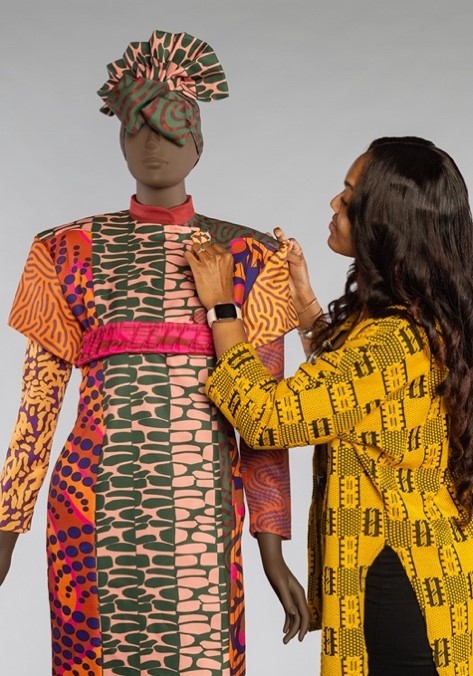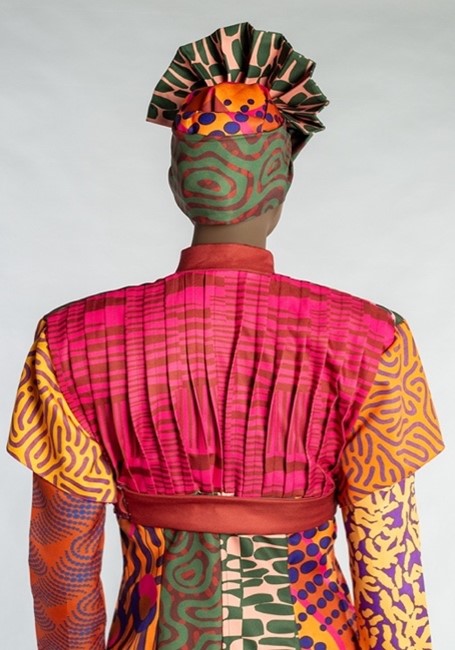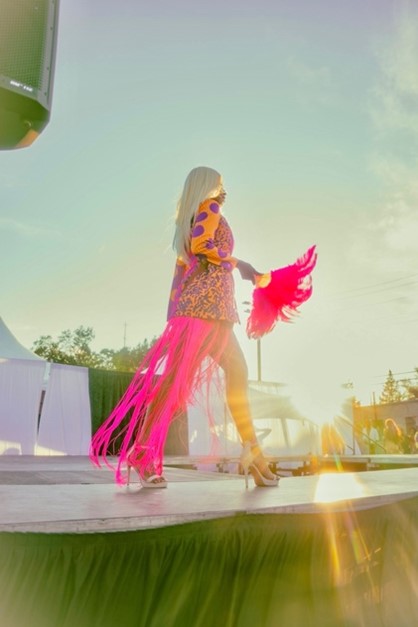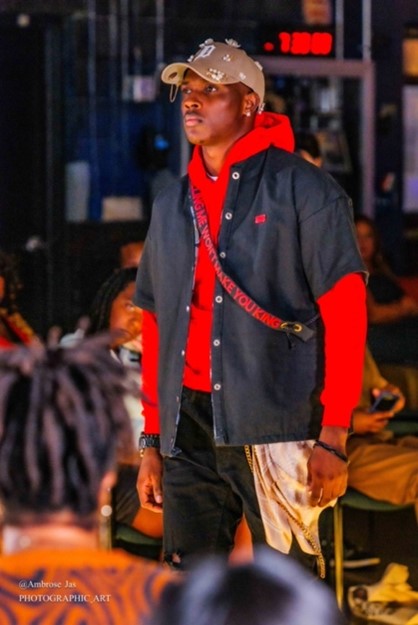Research Spotlight: LaDyra Lyte and "Redressing Fashion History: Pelisse"
September 30, 2024

LaDyra Lyte, a graduate student pursuing a masters in Textiles, Apparel & Merchandising with a concentration in Apparel Design, puts the finishing touches on one of her creations.
– Photo by: Kevin P. Duffy
Background and Early Influences
LaDyra Lyte received her Bachelor of Applied Arts in Fashion Design from Central Michigan University. During her undergraduate studies, she grappled with merging her experiences as a Black woman with her creative expression. One notable project, honored with the “Fashion and Social Justice” Award at the 2021 Detroit Month of Design and subsequently accepted by the Costume Society of America, was titled “Killing Me Won’t Make You King”. While not yet focusing on historic costume, the ensemble powerfully conveyed her message by fashionably and stylistically honoring victims of racial injustice, deepening her commitment to exploring Black culture and costume.
In her recent research at LSU, LaDyra embarked on a journey to reinterpret fashion history through an Afrocentric lens, starting with a 19th-century pelisse. This initiative aims to explore Eurocentric silhouettes and expand the narrative into the 19th-century Romantic period, ultimately forming the basis of her graduation thesis.
Drawing inspiration from her identity as a Black woman, LaDyra infuses her designs with personal experiences that fuel her artistic vision. Influences from notable artists such as Jean-Michel Basquiat, Yinka Shonibare, Alexis Quinney, and the Gee’s Bend Quilters, alongside concepts like Black dandyism and voices from scholars like Bell Hooks, Monica L. Miller and Tanisha C. Ford, have shaped her approach to historic costume and fashion. Even popular culture references, like the series “Bridgerton”, contribute to her diverse array of inspirations.
Her close relationship with the LSU Textile & Costume Museum has further enriched her knowledge. By studying and conducting conservation work on historical garments, she has refined her concepts and evolved as a designer. This process of rethinking silhouette creation not only honors the past but also infuses it with contemporary relevance. Through her work, she aims to contribute to a richer, more inclusive narrative in fashion history.
The Pelisse Project
LaDyra’s current project, "Redressing Fashion History: Pelisse" was recently accepted at the professional level for the International Textile and Apparel Association (ITAA) Conference, where she will be traveling this November to present her work. She noted that this project presented challenges, particularly in selecting appropriate prints and color combinations while avoiding the use of black and white. As an emerging designer, color theory was often an afterthought; she typically sketched in monochrome and later considered color in textiles. However, this project required color to take center stage. After creating a mood board and technical flat, she mock-patterned the garment in muslin to test fit and design appeal.
The design features a paneled skirt with multiple surfaces for displaying her custom prints, a stand collar, side seam pockets, and a back panel with an undulating tuck technique resembling pleats. Significant hand-stitching was involved, including invisible stitching at the cuffs and hem, self-covered buttons, bound buttonholes, and shoulder pads. The belt mirrors the upper back yoke and is secured with belt loops and a hook and eye.

Photo detailing Lyte's research titled, "Redressing Fashion History: Pelisse."
– Photo by: Kevin P. Duffy
Creative Process and Challenges
Throughout the process, she faced moments of discouragement, particularly while creating digital mockups of prints. She mentions:
“Pairing prints isn’t easy. Not everything matches or flows, and this design was a very bold endeavor. When translating that artwork into a garment, you have to consider placement, alignment, color stories, mood, the movement and texture of the print, and its complexity. It can become tedious, and impatience can easily creep in. My discouragement stemmed from all of this, as well as stretching myself creatively. I had to ‘trust the process’, so to speak, and learn to be okay with the chaos before arriving to a glorious outcome.”
Ultimately, she produced twelve finished prints, of which eight were selected. These were printed on polyester twill by Contrado, allowing for minimal waste. The fabric remnants were even used for a headwrap inspired by Alexis Quinney and the Tignon Law of 1786, which mandated that Black women wear headscarves.
The fashion industry is gradually moving toward greater inclusivity, making the reinterpretation of historic garments particularly compelling. Rather than relying solely on AI-generated images, LaDyra emphasizes the importance of craftsmanship. By employing ancient techniques, she bridges the gap between history and modernity, allowing her to immerse herself in past eras while gaining a deeper understanding of their couture.
Career Development and Advice
Outside of academia, LaDyra participated in two fashion shows this year, viewing these experiences as essential for honing her craft and expressing her evolving identity. Reflecting on her journey, she emphasizes the importance of authenticity and courage. Her Major Professor, Dr. Michael Mamp, encouraged her to recognize her talent and take bold steps forward.
Her best advice for aspiring designers is simple, "just do it and don’t be afraid to be great.” She believes that every creation, whether driven by passion or not, contributes to growth and experience in the ever-evolving world of fashion.

Lyte showed off her creations via 2 fashion shows within 2024.
– Photo by: DreLamont Photography

Lyte showed off her creations via fashion shows within 2024
– Photo by: Jas Ambrose
I’m truly excited about the designer I’m evolving into and the direction my research is taking me. I can’t wait to see everything come together and share it with the world.
LaDyra Lyte, graduate student
“ We love Agriculture! ”